The “impossible” series continues with an interesting Step 7 twist. Give it a go on your own, or follow the lead on this grid.
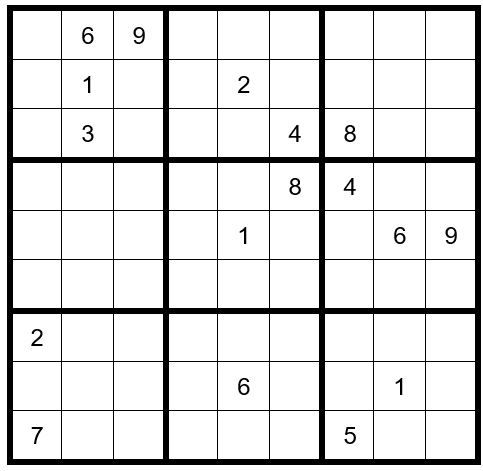
DAN’S 8-STEP APPROACH TO SOLVING ALL SUDOKU PUZZLES
Once you have completed the puzzle, to the extent that you have filled-in all obvious answers and have written all potential options across the top of the unsolved cells (PUZZLE PREPARATION), Dan recommends the following Steps to complete the puzzle.
Step 1: Sudoku Pairs, Triplets and Quads – See September 2015
Step 2: Turbos & Interaction – See October 2015
Step 3: Sudoku Gordonian Rectangles and Polygons – See November 2015
Step 4: XY-Wings & XYZ Wings – See December 2015
Step 5: X-Wings – See January 2016
Step 6: DAN’S YES/NO CHALLENGE
Step 7: DAN’S CLOSE RELATIONSHIP CHALLENGE
Step 8: AN EXPANSION OF STEP 7Steps 1-5 are relatively common techniques and are explained in the TI LIFE articles above. Steps 6-8 are covered in detail, in Dan’s book.
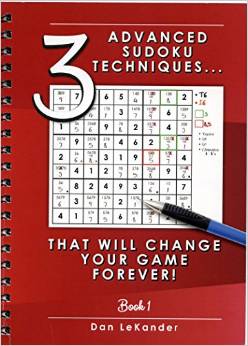
PUZZLE PREPARATION
Prior to utilizing techniques first complete the 5 Steps of Puzzle Preparation …
1. FILL IN DATA FROM OBSERVATIONS
2. FILL IN OBVIOUS ANSWERS
3. FILL IN NOT-SO-OBVIOUS ANSWERS
4. MARK UNSOLVED CELLS WITH OPTOINS THAT CANNOT EXIST IN THOSE CELLS
5. FILL IN THE OPTIONS FOR THE UNSOLVED CELLS
First, we will look for obvious pairs. C3R7 & C3R9 are the only two unsolved cells in box seven that can have options 1 & 6, so mark your grid as such, giving you Example #67.1 below:
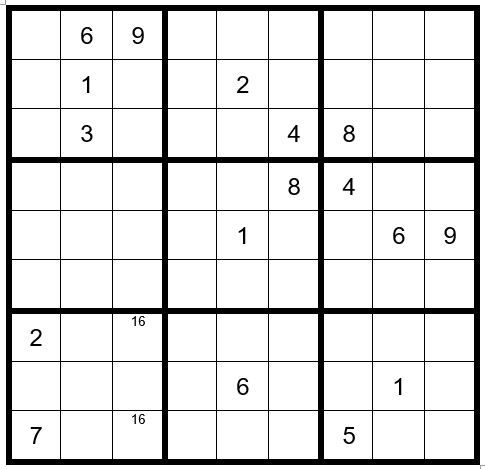
Now we will complete all of the first 4 steps in the order we observe them, versus all step 1, then step 2, step 3, and step 4 in order, before we move on to step 5.
We will start with the 1’s and navigate through 2’s to 9’s, then repeat the process until we conclude all step 1-4 clues.
The first thing we observe is that C3R3 (cell in column 3, row 3) =2 (obvious answer). Then, C3R2=7.
C1R1, C1R2 & C1R3 must have options 458. There is already a 4 and 8 in row 3; therefore, C1R3=5. Indicate that C1R1 & 2 must have options 48.
The remaining unsolved cells in column 1 must have options 1, 3, 6 & 9. There is already a 1, 6 & 9 in row 5; therefore C1R5=3.
The remaining unsolved cells in column 1 must have options 1, 6 & 9. There is already a 1 and 6 in row 8; therefore, C1R8=9, and the remaining two unsolved cells in column 1 must have options 16.
C3R8=3.
In box 6 an 8 can only exist as an option in C8R6 or C9R6; therefore, an 8 cannot exist in C2R6 or C3R6.
In column 7 the only two cells that can have options 69 are C7R2 & C7R7. Mark them.
An 8 must exist as an option in C2R7, C2R8 or C2R9; therefore, an 8 cannot exist as an option in C2R5, leaving C3R8 the only unsolved cell in box 4 that can be an 8. C3R5=8. C3R6=4. C3R4=5. C4R5=4.
The only two cells in box 6 that can have a 5 as an option are C8R6 & C9R6; therefore, a 5 cannot exist as an option in C4R6, C5R6 or C6R6; therefore, C6R5=5.
Now your grid should look like Example #67.2 below:
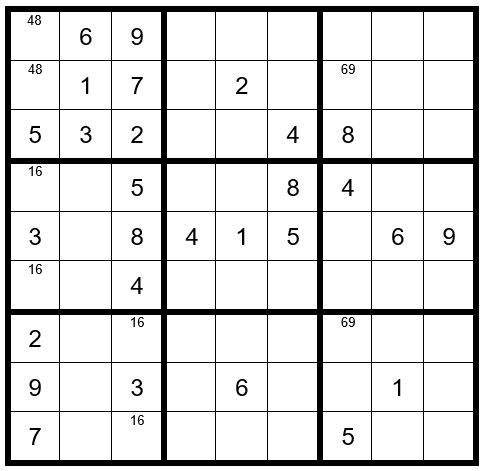
This concludes Puzzle Preparation except for filling the options for the remaining unsolved cells. Now your grid should look like Example #67.3 below:
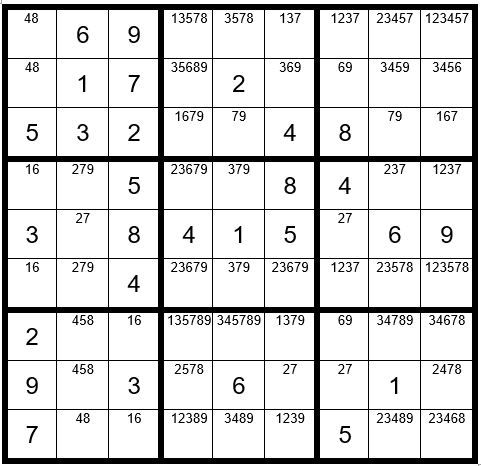
STEPS 1-5
Starting with Step 1, there is an obvious pair 79 in row 3. You can eliminate the 7 & 9 from C4R3 and the 7 from C9R3.
In row 8 there is an obvious pair 27, allowing us to eliminate the 2 & 7 from any other unsolved cells in row 8.
In column 5 there is a triplet 379, allowing us to remove those 3 options from any other unsolved cells in column 5.
In column 7 there is an obvious pair 27, allowing us to remove the 2 & 7 from any other unsolved cells in column 7.
In row 9 we have a new obvious pair 48. Process.
In box 6 there is a hidden pair 58, allowing us to change the options for those two cells to 58.
In box 5 a 3 can exist as an option only for C5R4 or C5R6 (Interaction), allowing us to remove the 3 as an option from all other unsolved cells in box 5.
In box 8 we now have an obvious triplet 458, allowing us to remove the options 458 from other unsolved cells in box 8.
Now your grid should look like Example #67.4 below:
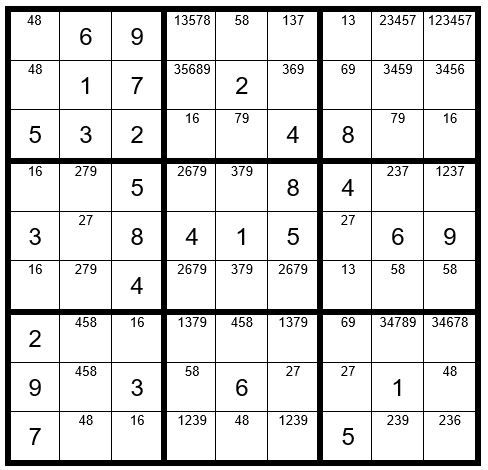
This concludes Step 1-5 clues, and there are no productive Step 6 clues.
We will move on to Step 7: Dan’s Close Relationship Challenge. In this exercise we will select any two-option unsolved cell as the driver cell. My first choice is C1R6 with the sequence 6,1 as marked below in Example #67.5. I chose this cell and sequence because the cell has two adjacent unsolved cells with 6 as an option and the 1 may track through the puzzle to give us significant information.
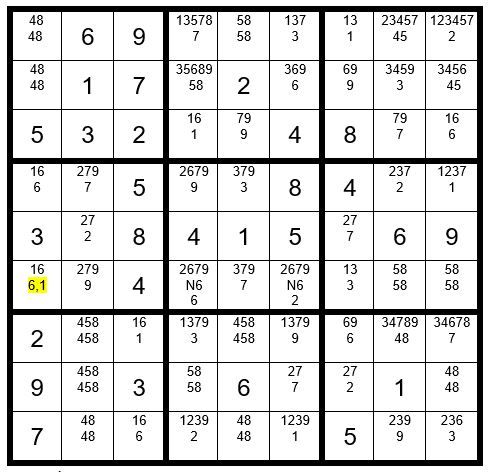
We know that C1R6 must be a 6 or 1. First, we will assume it is a 6. If this is true, then C4R6 & C6R6 cannot be a 6 (hence the notation N6).
Next, we will assume C1R6 is a 1. We will track the 1 through the grid on the next lower level to see the value of unsolved cells. Tracking in this fashion preserves the original puzzle on the top level of each cell. If an N6 cell is a value other than 6, then we know that it is not a 6 regardless of whether C1R6 is a 6 or 1.
We track C1R6 being a 1 through the grid above in the lower level of each unsolved cell in Example #67.5 above. Tracking seems to stall at this point. So what have we learned? If our driver cell C1R6 is a 1, then C6R6 is not a 1. If C1R6 is a 1, then C6R6 is a 2; therefore, it is not a 6 regardless of whether C1R6 is a 1 or 6. You can eliminate the 6 as an option from C6R6, giving us Example # 67.6 below:
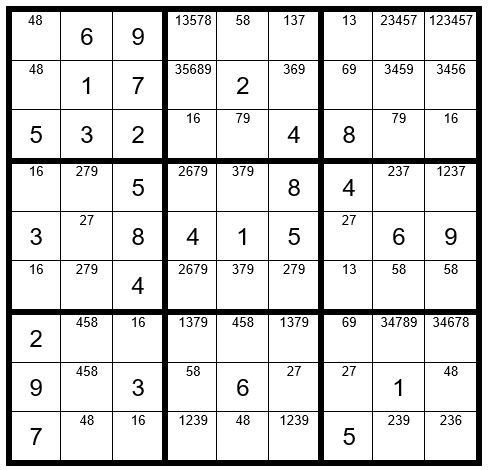
That seems like a lot of work to eliminate one option from one unsolved cell! But what else can we learn from this? Now there are only two unsolved cells in box 5 that have the option 6, C4R4 & C4R6, creating an interaction eliminating the 6 from any other cell in column 4. Now your grid should look like Example #67.7 below:
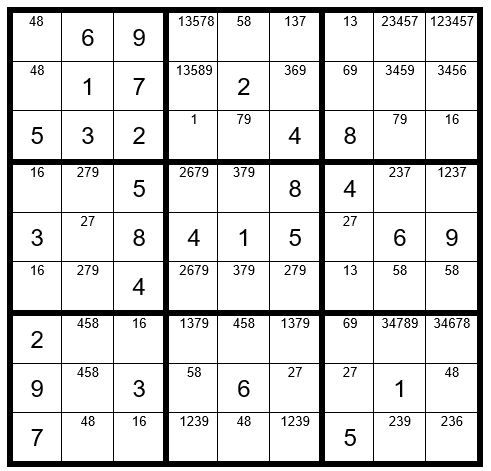
We see that C4R3=1. It follows that C9R3=6, C7R2=9, C7R7=6, C3R7=1, C3R9=6, C6R9=1, C5R3=9, C8R3=7, & C6R2=6. Now your grid should look like Example #67.8 below:
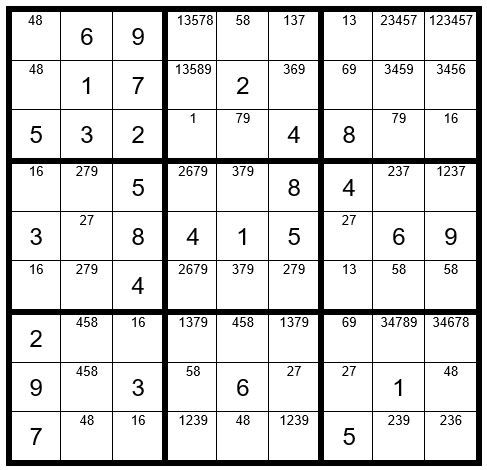
We made excellent progress, so we’ll try another Step 7 exercise below:
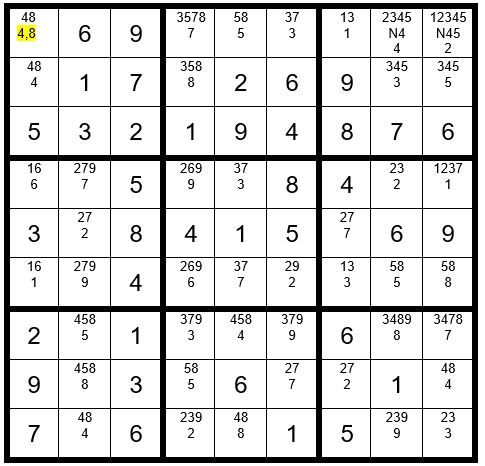
We will pick the driver cell to be C1R1 with sequence 4,8 in the above example. We establish our N4 cells, and then track the 8 through the grid. The 8 tracks to completion without any duplicates in a row, column or box. We have solved the puzzle!
May the gentle winds of Sudoku be at your back.
By Dan LeKander, Wellesley Island
